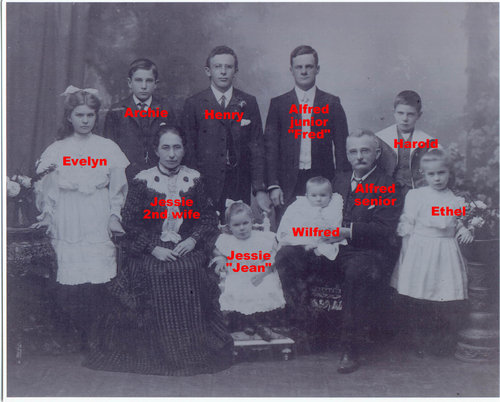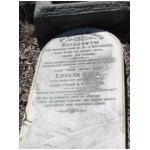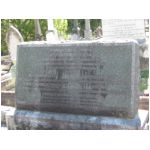Alfred John Raymond

Alfred John Raymond was mayor of Brisbane in 1912.
Contents
|
Early Life
Alfred was born on 1 Feb 1856 in Clifton, Bristol, England to parents Henry George Raymond and Mary Ann (nee Hewland), the 5th of 8 children. The family lived at 16 Camden Terrace, Clifton.
Alfred like his father was a carpenter and builder by trade and was probably apprenticed to his father. Apart from this, we know little of his early life, other than that his family were staunch supporters of the Hope Chapel, a Congregational Church a few streets from their home. Alfred was a deeply devout man throughout his life and an active lay worker in the Congregational Church.
Immigrating

In 1878 Alfred married Elizabeth (Bessie) Paul and they had two sons, Alfred (known as Fred, born 1879) and Leslie (born 1882). Elizabeth suffered from some illness, possibly tuberculosis, and it was advised that she move to a warmer climate for her health. So the family immigrated to Queensland on the "Duke of Buckingham", arrived at Cooktown on 27 January 1884 and then continued south to Brisbane.
According to the Queensland Post Office Directory for 1885-1886, Alfred was a carpenter and living at Morrison's cottages, Stanley Street on the south side of Brisbane beside the river. Today this is around the Kurilpa Point parkland beside the William Jolly Bridge.
However, it was not a happy time for the newly arrived Raymond family. Shortly after their arrival in Brisbane, their baby son Leslie died on 4 April 1884 and then exactly two years later (4 April 1886) Bessie died. Bessie and Leslie are buried together in Toowong Cemetery. Devastated by Bessie's death, Alfred is said to have returned to England with his surviving son Alfred (known as Fred), only to decide on returning that the climate was better in Brisbane and so he come back to Brisbane. However, there is no proof of these journeys took place, but equally there are no records of Alfred in Brisbane in years immediately afer Bessie's death.
What is certain is that on 20 Jun 1888, Alfred marries again to Jessie
Shearer, the Brisbane-born daughter of Thomas Shearer and Jessie (nee
Harrower), in the Congregational Church in Wharf Street, Brisbane.
Political Life
In the 1890s, the Raymond family lived in "Avonmore", Salston Street, Kangaroo Point (Alfred's family home in Bristol was only a couple of blocks from the Avon River). It was while living at Salston Street that Alfred became interested in politics and in 1894 he was elected as alderman for the ward of Kangaroo Point. Although South Brisbane was then a separate town to Brisbane, Kangaroo Point was curiously a ward of Brisbane and not South Brisbane. The park at the end of Salston Street is named Raymond Park in honour of Alfred John Raymond's contribution to Kangaroo Point.
Alfred represented Kangaroo Point from 1894-1899 when he decided to resign from politics (reasons unknown). However, he was tp return to local politics as alderman for Kangaroo Point again from 1902-1903 and then from 1911 to 1924. He was mayor of Brisbane in 1912. He was extremely active in local politics and served on many committees:
- Works Committee: 1894-6, 1899, 1902, 1912, 1914, 1918-23
- Health Committee: 1895, 1899, 1911, 1915, 1918
- Parks Committee: 1896, 1899, 1902, 1911, 1914-5, 1921-23
- Ferries Committee: 1902
- Legislative Committee: 1897--8, 1911
- Finance Committee: 1898, 1911, 1913, 1915-6, 1919
- Building Act Committee: 1902
- City Organ & Theatres Committee: 1911
- Town Hall Special Committee: 1912-3, 1919-24
- City of Brisbane Incorporation Act Committee: 1912
- New Parks Special Committee: 1912-4
- Kennedy Wharf Special Committee: 1912
- City Engineer's Department Special Committee: 1912
- City Engineer's Office Staff Special Committee: 1912
- General Purposes Committee: 1913
- Wharfs Special Committee: 1913
- Ferries & Baths Committee: 1914-6
- Parks Special Committee: 1915
- Lighting Committee: 1918-23
- Markets Committee: 1919-21
- Vigilance Special Committee: 1919
- Entertainments Special Committee: 1920-1
- Works & Lighting Committee: 1923-4
- Parks & Gardens Committee: 1923-4
Timber Merchant
In those times, being an alderman was not regarded as a full-time job and despite his many civic duties, Alfred was also kept very busy with his business as a timber merchant. The business operated from a number of locations over the years, including near the docks at South Brisbane (close to the Victoria Bridge, now the Flag Court at South Bank Parklands), Holman Street at Kangaroo Point (now the Capt Burke Park), and later in Newstead near the gasometers. In addition, Alfred also operated as a builder, buying land in new estates (now Brisbane's inner suburbs) and building houses upon them, then selling them to the expanding Brisbane population. Alfred tragically lost his right hand in an accident at his timber mill and photos taken of him later in life always position him carefully so nobody will notice the missing hand (check the photo at the top of this page to see how the baby Wilfred is positioned on his lap to cover his right arm).
The timber mill at Newstead was virtually destroyed in a massive fire in August 1913. The fire was believed to have been started by children, but spread quickly through the timber yard. The fire brigade was summoned by the nearby tramway depot at about 5am. When the firemen arrived, the flames were described as rising 100 feet into the air. Firemen were summoned from many stations: headquarters, Fortitude Valley, New Farm, Windsor, Milton, Hamilton and Ithaca. The firemen worked desperately to prevent the fire spreading to adjacent premises, finally quelling the fire around 6pm. The damage was estimated at 30,000 pounds (hopefully Alfred had insurance).
Church Life
In addition to his civic duties and his business, Alfred was also an active participation in the Congregational Church (in particular the Wharf Street congregation). He attended many Congregational Church conferences (meetings where policy and other issues were discussed) and was for some time the President of the Congregational Union in Queensland.
Alfred was a very religious man, who took his family to church twice every Sunday. He was a strict father, but a strong believer in doing what he thought was right. He did not drink, but did keep a bottle of sherry at home for guests who did not share his views. He thought it was a man's responsibility to look after his extended family; apparently he supported some of his wife Jessie's family. He thought all men were equal regardless of race or colour; he said that there was no man of any colour for whom he would not stop to say Good Morning. He was a good singer.
Home and Family Life
Around 1900, Alfred decided to move to a newer larger home "Clifton" at 178 River Terrace (corner of Walmsley Street) at Kangaroo Point, opposite the Kangaroo Point cliffs. The house was named after Alfred's suburb back in Bristol. The move was prompted partly because he was now prospering in his business and partly because his marriage to Jessie had by then produced 6 children (Henry 1889, Ruby 1891, Archie 1893, Evelyn 1895, Elsie 1897, Harold 1899) in addition to his son Fred from his first marriage. Although Ruby and Elsie both died young, by 1900, there were 5 children to be accommodated and, as it would turn out, there would be three more children born at the new home (Ethel 1901, Jessie 1904, Wilfred 1906).
"Clifton" was a large wooden Queensland-style home. Being a timber merchant and builder, Alfred was able to have a large home. It was said to have a hall big enough for a game of childen's cricket, could accommodate two live-in servants in addition to the family, and many years later the house was sold and converted in 10 flats. Late in the 20th century, the house was relocated to Pullenvale (and converted back to a family home) so that the now-valuable River Terrace site could be redeveloped (but in 2006 it remains a vacant block).
Alfred and Jessie experienced many of the sadnesses of parents of this era, losing their youngest child Wilfred in a infantile paralysis (polio) and their son Archie to a sniper's bullet in World War 1. Their daughter Ethel was keen to go and work outside the home as a "business girl" (clerical work). However, Alfred did not approve of this plan and Ethel remained at home where (perhaps as a compromise) she acted as secretary and chauffer to her father (who had by then lost his right hand).
Later in life
 Alfred is buried in Toowong Cemetery
Alfred is buried in Toowong Cemetery
As an alderman for many years, Alfred had been involved in the planning for Brisbane's "new" city hall to replace the Brisbane Town Hall then in Queen Street. Alfred's name appears on the the foundation stone laid in 1920 among the list of aldermen.
In the 1920s (perhaps after he retired from politics), Alfred and Jessie and some of their children went to England to visit Alfred's family. The journey also included a visit to son Archie's war grave in the Flat Iron Copse Cemetery, Mametz near Albert, France.
Although he had retired from politics by then, Alfred and Jessie were included in the guests at the opening of the Brisbane City Hall by the Duke and Duchess of York in 1930, one of Brisbane's biggest gala occasions.
Jessie died in 1933 following many years of heart trouble. In January 1935, Alfred (then 78 years old) scandalised his family by marrying his third wife, May Evelyn Nott (nee Wright). May was in her late 50s and was the widow of Frederick Lancelot Nott, a Queensland parliamentarian. However, many believed that, after Jessie's death, Alfred had become very lonely living on his own in his large house at River Terrace, as his children had by then all married and established their own homes. The marriage was short-lived however, as Alfred died that same year on 14 Oct 1935. He was buried in Toowong Cemetery with his second wife Jessie and their three young children: Ruby, Elsie and Wilfred.
His third wife May survived Alfred by many years, dying in 1969. Her ashes were placed in the grave of her first husband Frederick Nott at Dutton Park Cemetery.